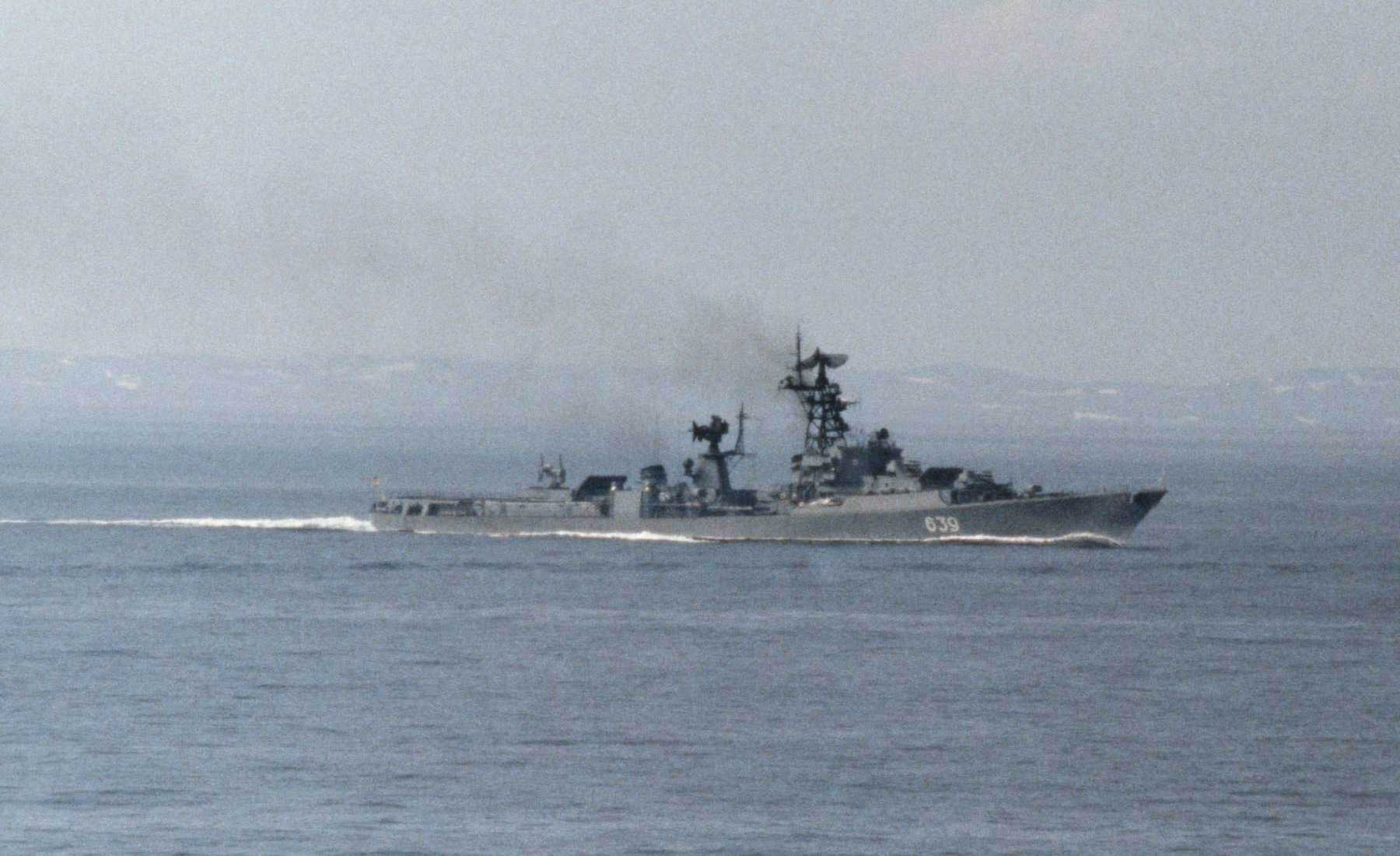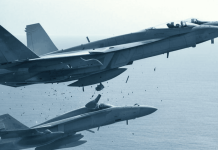As Ukraine continues to deploy lethal and technologically advanced unmanned naval vessels or drone boats, the Russian Navy appears to be training to prepare against this threat.
US Launches Hypersonic Missile In China’s ‘Red Zone’; B-52 Bomber Test-Fires AGM-183A ARRW From Guam
The crew of the Russian Pacific Fleet corvette “Gremyashchiy” conducted an exercise to combat unmanned boats in the Sea of Japan as part of a larger combat training program devised by the service, state news agency TASS reported.
“According to the plan of the exercise, the corvette “The Raunting” found a group of unmanned boats (BEC) of a conditional enemy moving towards the ship. The combat crews of the corvette <…>, which are in combat readiness to repel the attack, have worked out the algorithm of actions to distribute targets and fire in the sectors in case of a massive BEC attack,” the press service was quoted as saying.
The press service further stipulated that the corvette’s crew fired anti-aircraft artillery (AK-630M) and large-caliber machine guns. By the end of these drills, every target was eliminated.
Gremyashchiy is the lead ship of the Gremyashchiy-class corvettes, which are very large multipurpose vessels of the Russian Navy. These vessels can launch cruise missiles and are built with enhanced habitability for longer-duration missions.

This development comes as Ukraine has deployed a menacing and powerful weapon: unmanned boats. These boats launch high-stakes attacks against large and sophisticated Russian vessels. Besides training on how to counter this threat more effectively, Russian officials are contemplating other ways to eliminate the threat.
Russia’s choice of location to practice these maneuvers is significant. Russian ally North Korea has been firing missiles into the East Sea or the Sea of Japan in recent days.
On March 18, the country fired three short-range ballistic missiles into the sea. Although the Russian press note did not mention North Korea, Moscow has been accused of securing munitions and ballistic missiles from Pyongyang.
The US, Japan, and South Korea frequently conduct military drills in the Sea of Japan to counter North Korea’s nuclear missile threats. NATO has also forayed into the region and is now targeting China and teaming up with Taiwan. Although this does not affect Russia directly, it is aware that this grouping in this region is inimical to its interests.
More importantly, Russia is aware of the massive threat posed by these unmanned sea vessels and the extent of damage they may cause to a bigger and more advanced fleet. Sea drones have emerged as one of the significant weapons deployed by the Ukrainian military, which does not have a regular navy, unlike the Russians.
Latest Defence Intelligence update on the situation in Ukraine – 19 March 2024.
Find out more about Defence Intelligence's use of language: https://t.co/OU9Qq7F1Ee #StandWithUkraine 🇺🇦 pic.twitter.com/GHPjJC5ML0
— Ministry of Defence 🇬🇧 (@DefenceHQ) March 19, 2024
According to a recently published British intelligence update, Russian Defense Minister Sergei Shoigu visited the Black Sea Fleet (BSF) headquarters in Crimea on March 17 against the backdrop of mounting unmanned surface vessel (USV) attacks on the fleet.
Shoigu reportedly announced new measures for the BSF to mitigate the threat of uncrewed aerial vehicles and uncrewed surface vehicles.
The Russian Defense Minister emphasized anti-UAV and anti-USV exercises to enable the crew of Russian BSF ships to repel these attacks during the day or at night. Shoigu is also known to have ordered additional large-caliber weapons to unknown vessels to augment their defenses. Thus, the recent drills conducted in the Sea of Japan or the East Sea seem to be a part of the larger attempt at combating Ukrainian sea drones.
The Head of the All-Russian Fleet Support Movement (DF), Captain of the 1st rank Vladimir Maltsev, told TASS recently that the existing and promising ultra-small submarines already present in Russian inventory should be used to fight underwater drones.
“There should be ultra-small submarines in the Russian Navy. And we have them today, but there are not so many of them. They can be used for research purposes for combat sabotage purposes. There should be a lot of them in every fleet. They must also have the ability to counter underwater drones. Based on the existing realities, they need additional weapons to solve new problems,” Maltsev said.
Ukraine’s Sea Drones Are Russia’s Kryptonite
Ukraine asserts that it is the first nation to have a specialized division tasked with manufacturing drone boats. Unmanned vessels, commonly referred to as drone boats or maritime drones, have long had a wide range of uses. They have been used for surveillance, coastal patrols, scientific research, and search and rescue missions.
Ukraine packs these vessels with explosives and deploys them against Russia. These drone boats have a low radar signature that makes them difficult to spot as they race across the water’s surface, leaving a wake of white foam behind. Additionally, they have sophisticated GPS and camera systems installed on them.
Earlier this year, Ukraine employed six MAGURA V5 multi-purpose unmanned surface vessels (USV) to sink a Russian Tarantul-III class missile corvette named Ivanovets. During the operation, the naval drones delivered six direct hits to the hull of the Ivanovets, causing it to roll astern and ultimately sink.

The “MAGURA” drones are powered by jet skis and are only a few meters long. These drone boats are considered lethal owing to their 800-kilometer range. This allows the Ukrainian military to fire these drones from across vast stretches of Ukraine’s shoreline for operations against Crimean targets.
After a few days, the Ukrainian military announced it used high-tech naval drones to sink a Russian landing ship, the Caesar Kunikov amphibious ship, in the Black Sea. The vessel sank four kilometers in the Crimea peninsula, just 10 days before the second anniversary of the Russian invasion.
These unmanned boats are extensively deployed by the Ukrainian military to target Russian infrastructure and transportation in the Black Sea. By damaging and sinking Russian BSF ships in the Crimea peninsula, Ukraine has been able to resume some grain exports.
Let's meet Ukraine's Sea Drone family.
L to R
‘Toloka' (plays underwater)
'Marichka' (her too)
'Mykola' (Nicholas)
'Magura' (fast)
'Sea Baby' (grew up fast)
‘Kozak Mamai' (Cossack Mamai, folkloric hero)I would like the whole collection, please.
. pic.twitter.com/oYKQDSMyo9— Roy🇨🇦 (@GrandpaRoy2) March 16, 2024
Ukrainian navy drones hit a Russian ship for the first time in October 2022 when they were moored off the shore of seized Crimea and have not ceased since. Despite being outnumbered and outgunned in the conflict with its bigger neighbor, Ukraine’s audacious underwater drone strikes have raised spirits among its troops.
Since Ukraine has essentially become a test bed for new military technology and the assessment of its efficacy in modern combat, several countries are now turning to manufacturing sea drones. The United States, for one, is experimenting with sea drones to deter a Chinese invasion of Taiwan.
The Taiwanese military is also contemplating purchasing 200 units of an uncrewed surface vessel (USV) that can be used for multiple purposes. They include target drones and drones equipped with detachable modules for electronic intelligence (ELINT), reconnaissance, surveillance, and attack-oriented warheads.
Reports say the plan is influenced by Ukraine’s successful use of kamikaze USVs in the Black Sea against Russian warships of its Black Sea Fleet (BSF).
- Contact the author at sakshi.tiwari9555 (at) gmail.com
- Follow EurAsian Times on Google News




